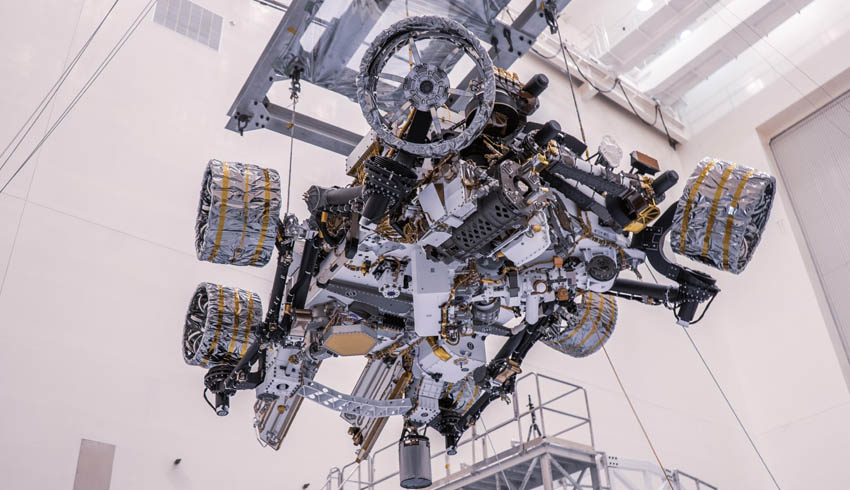SHERLOC, an instrument on the end of the rover's robotic arm, will hunt for sand-grain-sized clues in Martian rocks while working in tandem with WATSON, a camera that will take close-up pictures of rock textures.
Together, they will study rock surfaces, mapping out the presence of certain minerals and organic molecules, which are the carbon-based building blocks of life on Earth.
SHERLOC was built at NASA's Jet Propulsion Laboratory in southern California, which leads the Perseverance mission; WATSON was built at Malin Space Science Systems in San Diego.
For the most promising rocks, the Perseverance team will command the rover to take half-inch-wide core samples, store and seal them in metal tubes, and deposit them on the surface of Mars so that a future mission can return them to Earth for more detailed study.
SHERLOC will be working with six other instruments aboard Perseverance to give us a clearer understanding of Mars. It's even helping the effort to create spacesuits that will hold up in the Martian environment when humans set foot on the Red Planet. Here's a closer look.
SHERLOC's full name is a mouthful: Scanning Habitable Environments with Raman & Luminescence for Organics & Chemicals.
Raman refers to Raman spectroscopy, a scientific technique named after the Indian physicist C.V. Raman, who discovered the light-scattering effect in the 1920s.
Luther Beegle of JPL, SHERLOC's principal investigator, said, “While travelling by ship, he was trying to discover why the colour of the sea was blue. He realised if you shine a light beam on a surface, it can change the wavelength of scattered light depending on the materials in that surface."
This effect is called Raman scattering. Scientists can identify different molecules based on the distinctive spectral "fingerprint" visible in their emitted light. An ultraviolet laser that is part of SHERLOC will allow the team to classify organics and minerals present in a rock and understand the environment in which the rock formed. Salty water, for example, can result in the formation of different minerals than fresh water.
The team will also be looking for astrobiology clues in the form of organic molecules, which among other things, serve as potential biosignatures, demonstrating the presence of life in Mars' ancient past.
Nonbiological processes can also form organics, so detecting the compounds isn't a sure sign that life formed on Mars. But organics are crucial to understanding whether the ancient environment could have supported life.
When Beegle and his team spot an interesting rock, they'll scan a quarter-sized area of it with SHERLOC's laser to tease out the mineral composition and whether organic compounds are present. Then WATSON (Wide Angle Topographic Sensor for Operations and eNgineering) will take close-up images of the sample.
It can snap images of Perseverance, too, just as NASA's Curiosity rover uses the same camera – called the Mars Hand Lens Imager on that vehicle – for science and for taking selfies.
But combined with SHERLOC, WATSON can do even more: The team can precisely map SHERLOC's findings over WATSON's images to help reveal how different mineral layers formed and overlap.
They can also combine the mineral maps with data from other instruments – among them, PIXL (Planetary Instrument for X-ray Lithochemistry) on Perseverance's robotic arm – to see whether a rock could hold signs of fossilised microbial life.
Perseverance is a robotic scientist weighing about 1,025 kilograms. The rover's astrobiology mission will search for signs of past microbial life.
It will characterise the planet's climate and geology, collect samples for future return to Earth, and pave the way for human exploration of the Red Planet. No matter what day Perseverance launches during its 17 July-11 August launch period, it will land at Mars' Jezero Crater on 18 February 2021.
The Mars 2020 Perseverance rover mission is part of a larger program that includes missions to the moon as a way to prepare for human exploration of the Red Planet.
Charged with returning astronauts to the moon by 2024, NASA will establish a sustained human presence on and around the moon by 2028 through the agency's Artemis lunar exploration plans.

